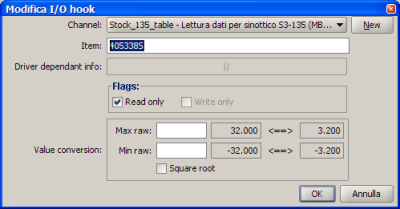|
I/O hooks are the things that link tags with remote device items.
An I/O hook can be added to a tag by clicking Add button of the I/O hook table in the Tag dialog.
The I/O hook dialog lets the user to:
- associate the I/O hook with a channel;
- define the item the I/O hook will be linked to within the remote device;
- specify some driver dependent information (if any);
- make the I/O hook to be read or write only.
- specify some tag type dependant configuration.

I/O hook channel
An I/O hook belongs to a channel that control when and how data are read/written from/to the remote device.
An I/O hook inherits some properties from it:
- the channel item prefix (if any) that will be prefixed to the I/O hook item to complete it.
- the remote device and the way it is read/written (timed/triggered, written on tag change).
- the driver used.
Item
The item defines the address within the remote device to be read/written by the I/O hook.
The channel can provide a prefix the all the items of the I/O hook that belong to it.
The format of this item is driver dependent.
Tag array element items
Items for I/O hooks of a tag array elements are calculated as a math expression where indexes of the element are provided in i, j and k variables (for a single dimensional array only i, for two dimension array i and j only).
For example: "%mw"+(1000+i)
Programmatically calculated items
See also:
Programmatically calculated items can be provided to I/O hooks, expecially useful for structured tag members o array elements (see below for array special case).
If the item starts with the prefix "::=" the rest of the item is interpreted with the following special place holders that let Java method or JavaCodeFunction to be called to provide the item:
%JavaCodeFunctionForTag javaCodeFunctionName%
Will be replaced with the value of the given JavaCode functions, that must return a String value and must have a single TagRef parameter (a reference to the tag instance, or the array element). For example:
::=%JavaCodeFunctionForTag ifEntryOID%
 JavaCode function JavaCode function
TagRef structTag = tag.getStructTag();
String ifEntryChild = ((TagStructMemberRef)tag).getMemberDefinition().getProperty( "ifEntryChild" );
if( ifEntryChild == null ) ifEntryChild = "999";
return "1.3.6.1.2.1.2.2.1."
+ifEntryChild+"."
+structTag.getProperty( "ifIndex", "999" );
%JavaCodeFunctionForTagAndChanneljavaCodeFunctionName%
Will be replaced with the value of the given JavaCode functions, that must return a String value and must have two parameters:
- TagRef a reference to the tag instance, or the array element.
- ChannelInfo information about the channel the item will be provided to.
%callForTag full.package.class.methodName%
Will be replaced with the value of the given static Java functions, that must return a String value and must have a single TagRef parameter, where a reference to the tag instance (or array element). This can be useful to invoke library class methods defined in JavaCode imports (see JSup Application properties)
To provide programmatically calculated items to an array element provide, as item math expression, a single double quoted string constant that starts with "::=", for example:
"::=%JavaCodeFunctionForTagAndChannel addressForDeviceTime%"
Driver dependant info
Some driver require or allow to enter some extra configuration data.
Press the button (if enabled) to enter such data.
Read/write only
It's a good practice to specify if an I/O hook is to be only read or written.
A read only I/O hook that belongs to a channel that is both read and written will never be written to the remote device. It will be simply skipped when the channel content is written to the remote device.
A write only I/O hook will be never read from the remote device even if the channel is configured for read operations.
It's a good practice to specify if an I/O hook is to be only read or written, even if the channel is configured only for read or write because:
Type dependent config
Boolean
A boolean tag I/O hook can be reversed so when tag value of true corresponds to a 0 in the remote device, and a false tag value corresponds to a 1 in the remote device.
Numeric
A numeric tag I/O hook can define a min/max raw range to scale the tag value within its EU min/max range. The EU min/max range can be defined using the tag properties or defining it within the tag class. When no min (or max) is given from tag properties the Java corresponding type minimum (or maximum) value is used (See Byte, Short, Integer, Long, Float and Double).
Please note that is always better to define the raw value min-max range withing tag class. Use the I/O hook specific raw range only as exception (for example for a tag with multiple I/O hooks that need different scaling).
With a linear conversion (no square root) for conversion formulas are
vr = (ve - mine) * ((maxr - minr) / (maxe - mine)) + minr
ve = (vr - minr) * ((maxe - mine) / (maxr - minr)) + mine
Where the subscript r means raw (remote device side), and e means engineering (JSup side)
When the square root flag the following formula is used to convert the raw numeric value (read from the remote device) into the tag value:

Where the subscript r means raw (remote device side), and e means engineering (JSup side).
And the formula to convert the tag value into the raw value to be written to the remote device is:

The raw value sign can inverted specifying a min raw greater than the max raw. In this case, to perform calculations, the min/max raw values are swaped in the natural order, and the raw value sign is inverted.
Multiple I/O
A tag can have more than one I/O hook. In this case the I/O hooks of a tag should belong to different channels that should be triggered read/written: the trigger should be handled by some JavaCode.
I/O hook list
The complete list of I/O hooks defined in the application can be viewed with the I/O hook list window.
| 











 Example of ifEntryOID( TagRef tag )
Example of ifEntryOID( TagRef tag )  JavaCode function
JavaCode function

 Non hai un account?
Non hai un account?